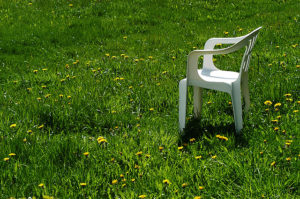Patience is a virtue when you are planning a garden. Think of it like constructing a building. Would you run out first and buy bricks and mortar? Of course not. You would first visit the site and look at all of its attributes – good and bad. You would make notes. You would test the soil to see if it could support the building you have in mind and make adjustments as needed. Next, you would draw up a plan for the building and get input from others. And the final step before laying the first brick would be to build a good foundation.
So it is, too, with gardens. Homeowners should sit and observe their site for four seasons before planting. Take a deep breath. I know you already have all of your plant catalogs dog-eared on the pages with the newest releases. But how much money, time, effort, water, pesticides, and fertilizer do you want to dump into the project? Are you installing a garden for enjoyment or to make sure you increase the amount of weekly chores you have? A little time now in a lawn chair will be the difference between delighting in your garden and cursing it.
Site Check
In each of the four seasons, you should makes notes of the following things. Many of the things on this checklist will change depending on the season. You will need your lawn chair for this.
Sun: What parts of the yard get the most sun and for how long? Where is there deep shade?
Wind: What direction does the wind come from? Are there existing windbreaks such as a shed, fence, trees, or neighbor’s house?
Drainage: Do you have wet spots that need to be addressed?
Family use: Where do the kids and pets hang out? What is the natural traffic flow?
Wildlife: How does the existing wildlife use the yard? If your dog chases the neighborhood squirrels along the fence, that is probably not a good place to plant delicate annuals.
Soil Test
Take a soil sample and send it off to be analyzed. It will cost you less than $100 and it’s worth every penny. Purdue University Cooperative Extension Service has a good guide on collecting soil samples for testing. Look at the composition of your soil. Is it mostly clay, sand, loam or a mixture of these? What nutrients are missing? What is the pH? If you are having trouble understanding the results, check out a soil test interpretation guide.
Draw Up a Plan
Start with a rough plan showing the direction of the sun and wind. Label large areas according to usage – a kids’ play zone, patio or outdoor kitchen area, vegetable garden, pet area, etc. Sketch in paths to indicate traffic flow. One note on paths: If your kids constantly cut corners across your flower beds to get to their favorite spot, go with the flow and make the paths follow them – or plant really thorny bushes along the walkway to keep them in line.
Next, start to refine the drawing, adding the structural backbones such as trees, boulders, retaining walls, fences, greenhouses, etc. Take into account how these structures will affect sun, wind, and traffic flow. In the case of the trees and large shrubs, consider how your site’s microclimate will change over time as the plants get larger.
Finally, add the bling. Which plants make you happy, and which ones end up being a lot of work? If you have children or pets, make sure delicate plants are kept in areas where they won’t succumb to Frisbees and footballs. The key is putting the proper plant in the proper place. Shade-loving plants do not like sun no matter how much you baby them. Plants that need constant watering should be grouped together.
Lay a Good Foundation
And now it’s time to go back to step two – the soil test. Look at the recommendations on the soil report and amend the soil to give your plants the best chance of thriving, not just surviving. Add a bountiful supply of organic material. If your soil is healthy and alive, your plants will need less fertilizer and have fewer disease problems. What you have below ground is key to how things grow above ground.
If you follow these simple steps, taking time to observe and laying a good foundation, you will be able to spend more time in that lawn chair you bought in step one. And in my book, a smart gardener is a lazy gardener… with a lawn chair.
Michael O’Loughlin is an OSU Wildlife Steward and Master Gardener. He was presented with the Horticulture Award by the Oregon State Federation of Garden Clubs in 2008 and given lifetime membership. He was also presented with the Tree Steward Award by the city of Tigard, Oregon. When he is not producing home and garden shows or testing gardening products, he is volunteering at school gardens. You can follow him on Twitter @molfamily.

